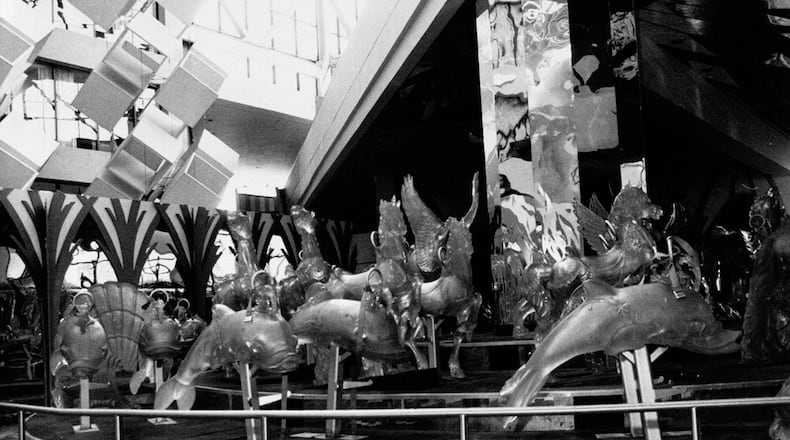It was hyped as “the most dynamic thing to ever hit any downtown in the world” by the late Atlanta Mayor Maynard Jackson when it debuted in May 1976 in the spanking new Omni International complex. Five months later it was eulogized by Business Week magazine as “one of the worst real estate disasters in history.”
For its developers, The World of Sid & Marty Krofft was a $20 million flop that would signal a downtown decline that took decades to reverse. But for those who were there, and many who weren’t, the indoor amusement park – which housed a crystal carousel, human pinball machine, tap dancing eagles, singing trees and Lidsville, where everyone and everything was a hat for some reason – remains a source of fascination some 44 years after its demise.
“It kind of reminded me of Alice in Wonderland,” said Bob Ingram, 62, of Kennesaw. “I found it mesmerizing, all the tunnels and crazy little things that would just pop up. It was trippy, no doubt. Of course were were all smoking something back then so it fit with the times.”
The park is a frequent topic on the popular Facebook group, “You’ve Lived in ATL a Long Time if You Remember.”
“My fondest memory of The World of Sid & Marty Krofft is the weekly post on this group asking if I remember The World of Sid & Marty Krofft,” wrote commenter Mark Schieber after its most recent mention a few weeks ago.
So how, then, did a place recalled so warmly fail so miserably?
Maybe it was the mimes.
‘Eighth wonder of the world’
In 1972, developers Tom Cousins and Maurice Alpert financed the $76 million Omni International, promoting it as a “city within a city,” sort of a Ponce City Market of its day. There were shops, restaurants, night life including a bar owned by the late actor Burt Reynolds and even an ice skating rink.
“With everything Atlanta has going for it right now, all the city needs to do is regain the confidence it had in the ’60s and it can live up to its ‘world’s next great city’ dream,” Alpert told The Atlanta Constitution in 1975. “We have designed Omni International to be part of that dream.”
Downtown Atlanta was a dramatically different city at that time. There were few high rises – the Peachtree Plaza, now known as the Westin, was the tallest. Rapid transit was three years away.
Still, “it was a vibrant, happening place,” said Lou Arcangeli, a retired Atlanta cop who worked the downtown streets in the mid-1970s. “It’s hard to imagine how busy it was.”
There were two major department stores, Rich’s and Macy’s. Underground Atlanta, a white elephant today, was filled with restaurants and nightclubs.
Yet there was a feeling the city’s best days had come and gone. Urban centers across the nation were ailing, with families flocking to the suburbs. Atlanta was no different.
What it needed, city leaders felt, was more family friendly attractions to add to Atlanta’s appeal for its growing convention and visitors industry. Omni International, meanwhile, needed to find a new occupant for a five-story pavilion that was to be a trade market. That idea was nixed when the Georgia World Congress Center opened next door.
Enter Sid and Marty.
The brothers Krofft were, at the time, America’s go-to brand for whimsy. The master puppeteers rivaled Disney in the 1970s, dominating children’s television with schlocky live action shows like “Dr. Shrinker,” “The Bugaloos” and “Land of the Lost.”
And they had theme park experience, designing rides and producing puppet shows for the Six Flags chain.
“We screwed with every kid’s mind,” Marty Krofft said in 2016 interview with The Hollywood Reporter. Of the park, “This was one of the eight wonders of the world. If it would’ve worked there would’ve been 20 more of these across the country.”
Raising the money for the the park was the first challenge. Cousins, in a 1976 interview with The Atlanta Constitution, said it was “a fairly agonizing process to convince the banks to get in on the project.” Outdoor amusement parks in the suburbs were one thing. Placing one indoors, and downtown, had never been attempted, not on this scale.
“It was a dramatic risk,” Cousins told The Constitution. Before the papers merged in 2001 to produce one daily newspaper, the Constitution and the Journal operated independently
For Cousins and his partners, the stakes were high. They bet heavy on Krofft world, believing it could help reverse the trend of urban flight while providing a template for other cities nationwide.
Credit: AJC
Credit: AJC
What’s an H.R. Pufnstuf?
Or maybe the better question: What were the Kroffts puffing? It’s a rumor that’s followed the brothers for years but they insist their creations were not hallucinogen-inspired.
(For the record, H.R. Pufnstuf was a dragon who served as mayor of Living Island. He provided shelter to a shipwrecked 11-year-old boy and his talking flute who had been lured to the island by the evil Witchiepoo.)
“It was a fun place to be,” said Kathy Keller, who was in college when she got a job as a greeter at the Krofft world. “You’d take that giant escalator up and entered this place that was just eye-catching. Everything was so colorful.”
The park opened for business on May 24, 1976. The Kroffts predicted 1 million visitors would pass through the gates in the first year.
But there were problems from the start. Customers complained about the ticket cost: $5.75 for adults, $4.25 for kids – more expensive than Six Flags. And while it took almost an entire day to enjoy all of Six Flags’ attractions, Krofft world could be experienced in a couple of hours.
“The crowds started to get smaller, especially on weekdays,” said Keller, now 66 and living in Daytona Beach, Florida.
Within five months attendance had dropped 50 percent. Meanwhile, operating costs continued to rise.
“We had technical problems that would kill any project,” Marty Krofft said in a 2013 interview with The Television Academy. “We created a carousel that you figure would run really easy but we had to have aerospace guys do it and that never worked. We had a lot of stuff that didn’t work.”
Eventually the banks cut off financing, and by September there was nothing left to do but end The World of Sid and Marty Krofft.
In the end, Atlanta shouldered much of the blame.
A violent city
“The problem with it, and why it didn’t work, was it was in downtown Atlanta,” Sid Krofft said in that same Television Academy interview. “In 1976 downtown Atlanta was very dangerous. The city promised they would clean up downtown and we just couldn’t hold out any longer.”
Fresh out of the police academy, Danny Agan was assigned to work downtown in the 1970s. The retired APD detective recalls a much more dangerous city.
“It was rough,” he said. “Lots of street crimes.”
Murders had decreased from 1975, from 185 to 154 — in 2019, the city recorded 100 homicides. The decrease in 1976 was but a blip, however, and would continue to rise through the decade.
“The 70s were terribly violent,” Arcangeli said. “Ten (APD) officers were killed by gunshot that decade. Yet the emphasis was more about what police were doing than crime in general.”
The World of Sid and Marty Krofft was no outlier. A slew of businesses abandoned downtown as the decade came to an end. In 1982, Underground Atlanta closed its doors, beset by the same problems that killed the indoor theme park.
Postscript
The Krofft brothers are still creating. Sid is now 91 and his brother Marty, 83. “H.R. Pufnstuf” and “Sigmund & the Sea Monsters” were recently remade and, according to their official website, new versions of “Electra Woman & Dyna Girl” and “Lidsville” are in the works, sans Charles Nelson Reilly.
Their weird world may have stood a better chance in today’s downtown. Atlanta is a “much, much safer city,” said Arcanangeli, though 2020 has seen a dramatic rise in murders.
Unlike the 70s, downtown no longer lacks tourist attractions. They may not have dragon mayors or mimes, but the Georgia Aquarium and the College Football Hall of Fame and the Center for Civil and Human Rights have emerged as popular destinations.
“Atlanta has gone through so many transformations,” said Ingram, 62. He, like many others around then, feel that while the city might be safer, it’s a bit on the bland side.
“It doesn’t have that buzz you get in cities where there’s more people living and working downtown,” Arcanangeli said.
Can a new development bring that back?
California-based developer CIM Group has proposed Centennial Yards, an up to $5 billion mix of apartments, offices, retail and hotels that would rise above the parking lots and rail lines between the Five Points MARTA station and State Farm Arena. The multi-year project would cover 40 acres of downtown property.
Centennial Yards enjoys the kind of backing the Kroffts could only dream about. The city ponied up with a record-breaking incentive package from the city of up to $1.9 billion in future sales and property tax dollars to help fund the development, which, at the moment, has no plans for an indoor amusement park. .
“It was of its time, to be sure,” Keller said. “Only in the 70s.”
About the Author
Keep Reading
The Latest
Featured






